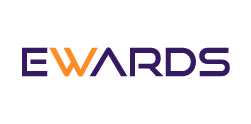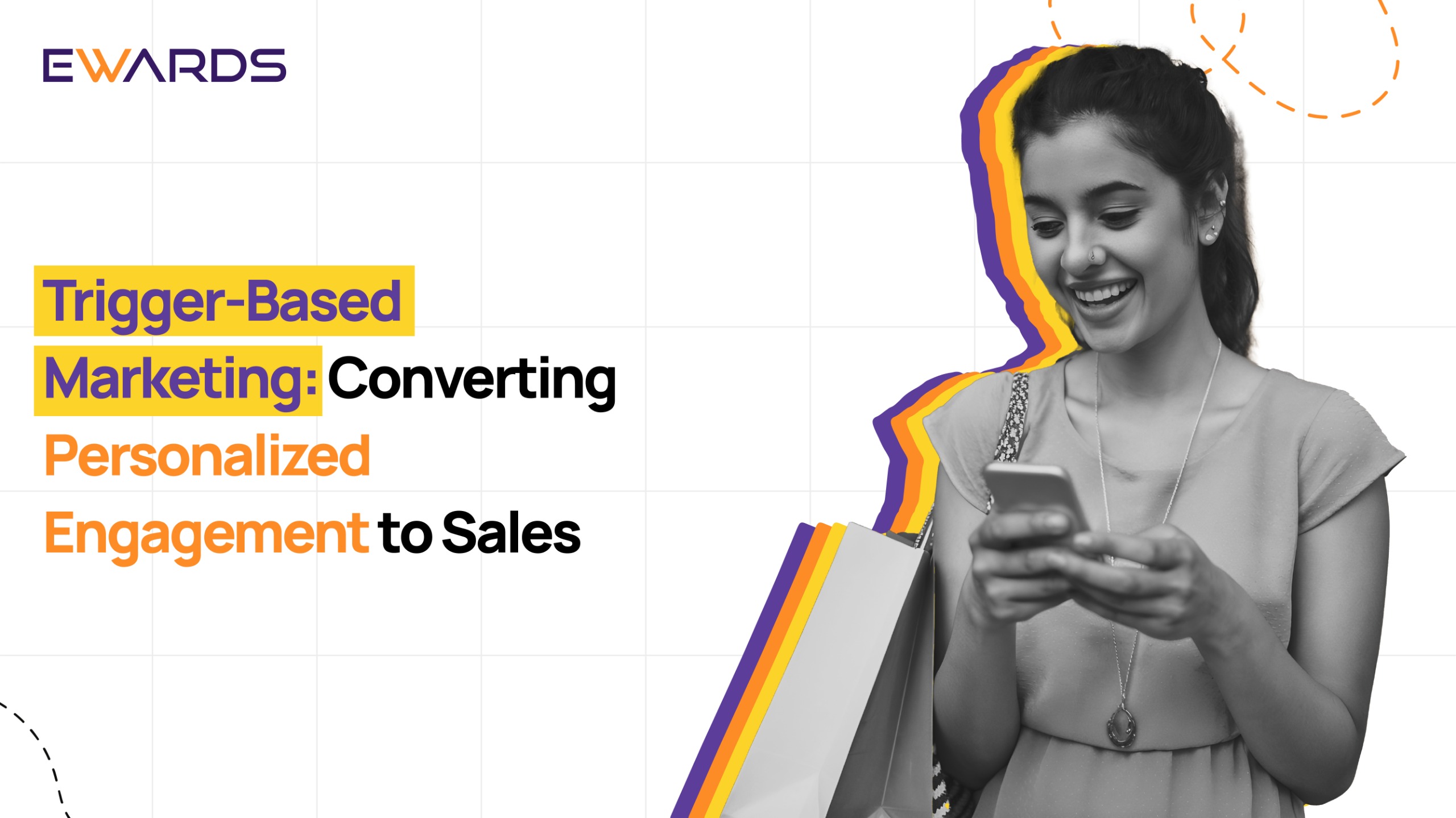
Why do some of your customers convert after the first interaction, while others never come back?
What’s the missing link? The answer: Trigger-Based Marketing.
In a world where attention spans are short and competition is fierce, simply sending out generic marketing messages isn’t enough. You need relevant, timely engagement, and this is where trigger-based marketing comes in.
A study by Mailmodo showed that triggered emails have a 70% higher open rate and a 150% higher click-through rate when compared to sending out generic marketing emails. That’s a massive opportunity to connect with customers at the right time and in the right context.
So, what exactly is trigger-based marketing, and why should you care? Keep reading to discover how you can use this powerful tactic to boost customer loyalty, improve conversions, and increase lifetime value.
What is Trigger-Based Marketing?
Trigger-based marketing refers to sending personalized messages or offers to your customers based on their specific actions or events. Studies from Salesforce show that personalized emails help in delivering 6x higher transaction rates, 29% higher open rates, and a 41% higher click-through rate. With this strategy, rather than sending generic campaigns, you’re capitalizing on behaviors like abandoned carts, birthday reminders, or even a customer’s first visit to your website.
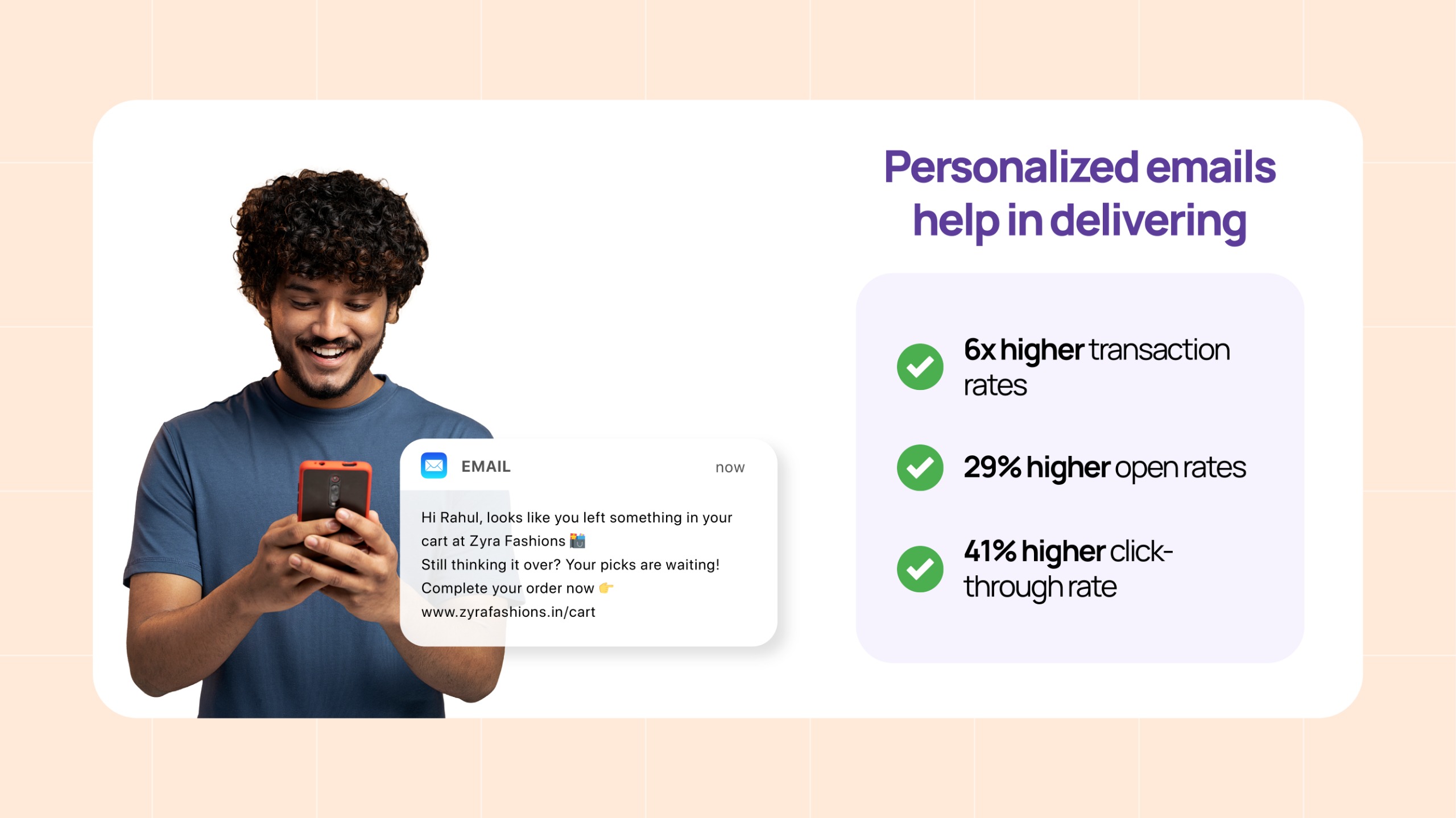
It’s a way of being reactive to your customer’s behavior rather than simply hoping they respond to your broad, one-size-fits-all promotions. Triggering the right message at the right time, like sending a special offer to someone who just signed up for your newsletter, will significantly improve your engagement.
How Does Trigger-Based Marketing Help in Customer Retention?
When customers interact with your brand (through browsing, purchasing, or signing up), those actions create opportunities for follow-up engagement. But just sending a generic “thanks for shopping with us” email won’t do. The key to driving long-term loyalty lies in triggering relevant, tailored follow-up actions because sending the right message at the right time has been shown to increase conversion rates and engagement.
Example:
Let’s say a customer browses through your website and leaves without purchasing. A cart abandonment reminder email could be sent, offering a small discount to encourage them to return and finish their purchase. These types of actions significantly increase the likelihood of converting a potential lead into a loyal buyer.
Types of Customer Triggers in Marketing
Customer triggers are the powerful moments that prompt immediate actions from your customers. When a business can correctly identify and capitalize on these triggers, it can boost customer engagement, improve conversion rates, and enhance brand loyalty. Understanding the types of customer triggers is vital for crafting personalized, impactful marketing campaigns.
But how exactly do customer triggers work, and how can you harness them in your marketing strategy? Let’s find out:
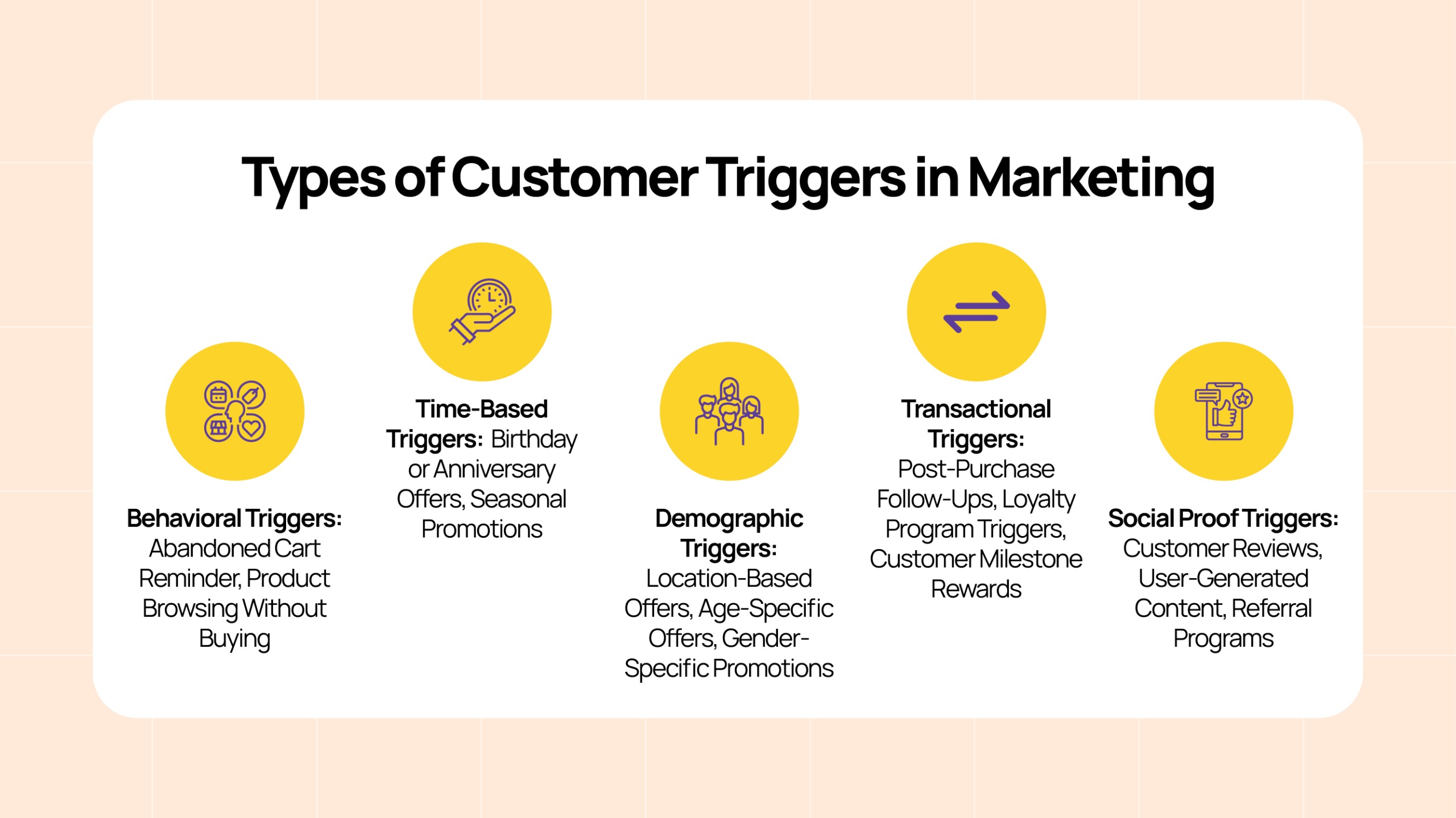
- Behavioral Triggers
Behavioral triggers are actions customers take while interacting with your brand. These triggers are based on specific customer behaviors, such as visiting your website, adding an item to their cart, or browsing a product. For instance, cart abandonment emails have a 39.07% open rate and 23.33% click-through rate, because customers love reminders in the form of abandoned cart emails.
Examples of Behavior Trigger:
- Abandoned Cart Reminder: A customer adds a product to their cart but doesn’t complete the purchase. Sending a reminder email or SMS with a personalized message and possibly an incentive (like a discount) can entice them to complete the transaction.
- Product Browsing Without Buying: A customer browses your product catalog but doesn’t make a purchase. You can trigger an email or push notification that recommends similar products based on their browsing history.
Why It Works:
Behavioral triggers rely on real-time actions and use data to create personalized, relevant messages, increasing the chances of conversion and customer engagement.
- Time-Based Triggers
Time-based triggers are actions initiated based on specific dates or times. These triggers can be particularly powerful because they play into customers’ seasonal needs, special occasions, or reminders.
Examples of Time-based Trigger:
- Birthday or Anniversary Offers: Sending personalized birthday or anniversary emails with an exclusive offer can significantly improve engagement and boost loyalty.
- Seasonal Promotions: Reminding customers of upcoming holidays or seasonal events (like Black Friday or New Year’s) and offering promotions to encourage purchases.
- Cart Abandonment After a Certain Period: If a customer abandons their cart and doesn’t return within a set period, a reminder or discount offer can trigger a follow-up action.
Why It Works:
Time-based triggers capitalize on external factors or calendar events that already impact your customers’ behavior. This makes your offers more relevant and time-sensitive, encouraging them to act quickly.
- Demographic Triggers
Demographic triggers are based on customers’ personal characteristics, such as age, location, income level, or purchase history. Tailoring offers to customers based on these factors can help you target specific segments with relevant content and promotions.
Examples of Demographic Triggers:
- Location-Based Offers: Offering discounts or promotions tied to a customer’s location, such as a local store’s grand opening, can encourage foot traffic.
- Age-Specific Offers: Offering discounts for specific age groups, like student discounts or senior citizen offers, can make your messaging more relevant and effective.
- Gender-Specific Promotions: Promotions targeting male or female customers based on their past behavior, such as offering men’s fashion items to male customers who have bought similar items in the past.
Why It Works:
By tailoring your marketing to specific customer segments, you create personalized experiences that resonate with individuals on a deeper level. This enhances customer loyalty and trust.
- Transactional Triggers
Transactional triggers are based on customers’ past purchases and behaviors. These triggers are designed to encourage repeat purchases, build brand loyalty, and increase customer lifetime value. A Growwave study highlights that repeat customers account for 40% of total revenue for most businesses, even though they only make up 8% of the customer base.
Examples of Transactional Triggers:
- Post-Purchase Follow-Ups: After a customer makes a purchase, send a personalized email thanking them for their purchase and recommending complementary products.
- Loyalty Program Triggers: Offering loyalty points or rewards after a certain number of purchases or spend. This encourages repeat business and helps improve customer retention.
- Customer Milestone Rewards: For customers who reach a certain spending threshold, sending them an exclusive offer or reward can make them feel valued and more likely to return.
Why It Works:
Transactional triggers leverage your existing relationship with the customer, making it easier to guide them towards making additional purchases. Customers who already trust your brand are more likely to engage with loyalty programs and offers that align with their past purchase behaviors.
- Social Proof Triggers
Social proof triggers use the influence of others to drive decisions. When customers see that other people trust a brand or have had a positive experience with it, they are more likely to make a purchase themselves. A WebFX Study shows that 83% of consumers trust recommendations from people they know or people like them more than any other form of advertising.
Examples of Social Proof Targeting:
- Customer Reviews: Displaying customer reviews and ratings prominently on your website or in your marketing materials can influence others to trust your product and make a purchase.
- User-Generated Content: Showcasing photos, testimonials, or experiences shared by real customers on social media or your website helps build trust.
- Referral Programs: Encouraging customers to refer friends in exchange for rewards creates a cycle of trust and social influence.
Why It Works:
Humans are social beings who tend to follow the actions of others, especially when making purchasing decisions. Social proof triggers create a sense of community, leading to increased trust and conversion.
The Role of CRM in Trigger-Based Marketing
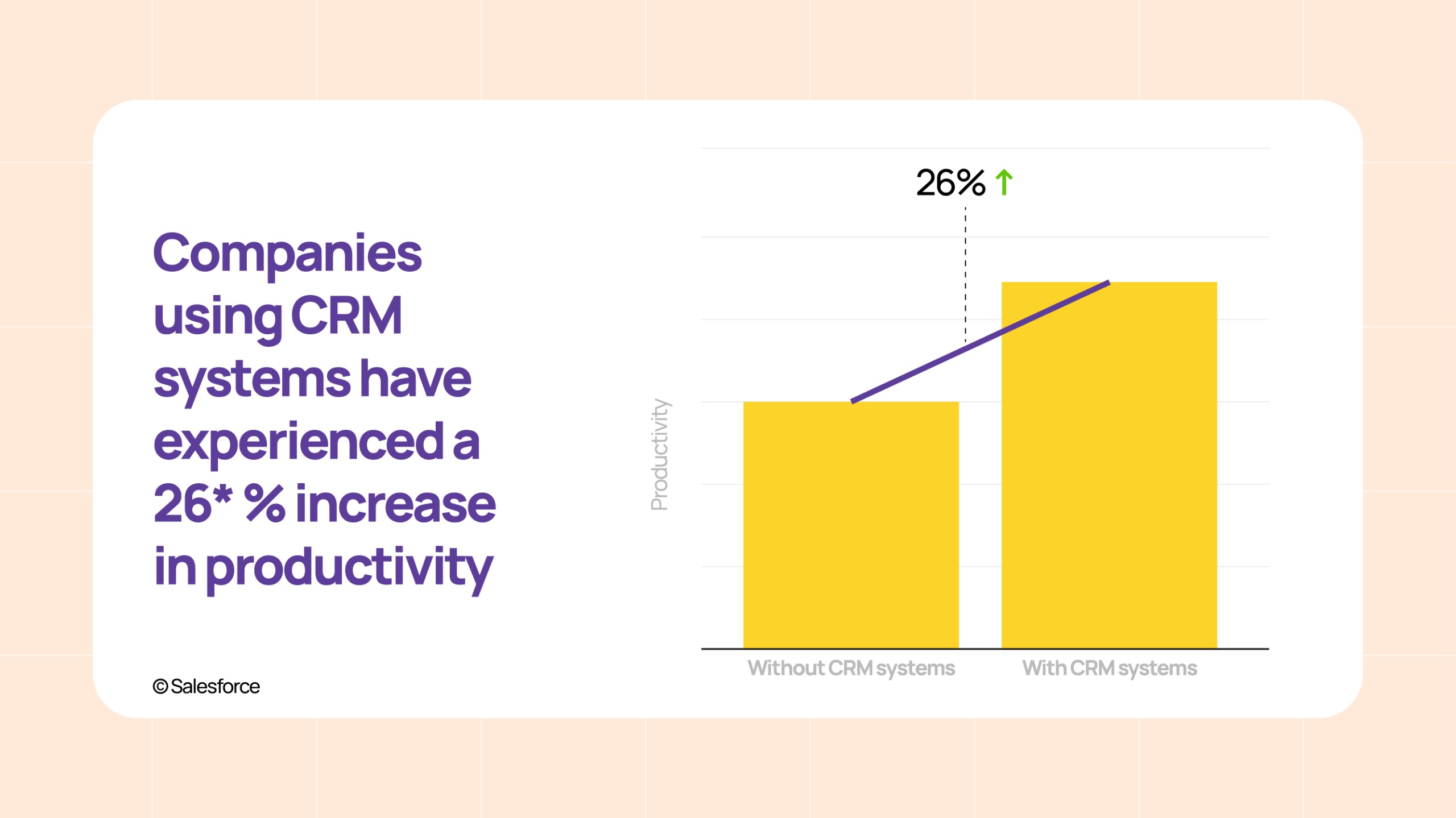
Thus, CRM systems are the backbone of trigger-based marketing, as they allow you to track and analyze customer behavior in real time. With CRM, businesses can:
- Automatically segment audiences based on triggers.
- Personalize communication and offers based on data insights.
- Measure performance to improve future campaigns.
Implementing Trigger-Based Marketing
Trigger-based marketing is all about reaching customers with timely, personalized messages that prompt action, based on their behaviors, actions, or key events. By leveraging customer data and automated workflows, brands can ensure they’re reaching the right audience at the right time with the right message.
Ready to harness the power of trigger-based marketing to drive results? Let’s dive in!
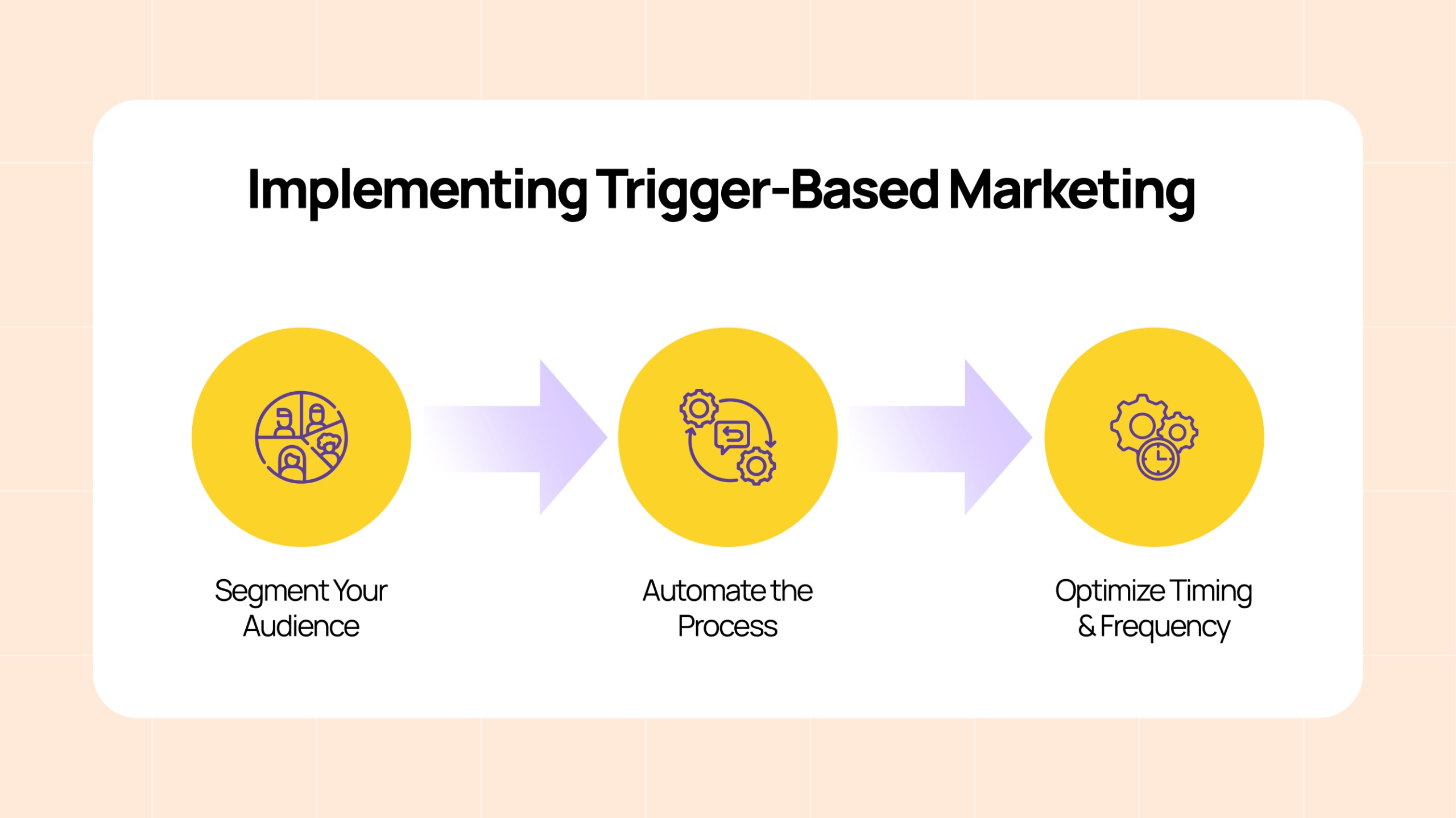
- Segment Your Audience
Leverage data from your CRM tools to segment customers based on their behavior. This allows you to send hyper-targeted messages that resonate with each group.
Example: If a customer frequently buys tech gadgets, send them an email highlighting the latest tech accessories when they log in.
- Automate the Process
Set up automated campaigns for key triggers. Use platforms like HubSpot, Mailchimp, or ActiveCampaign to create automated workflows for actions like:
- Product recommendations based on previous purchases.
- Loyalty rewards are triggered when a customer reaches a certain spend threshold.
- Optimize Timing & Frequency
The effectiveness of trigger-based marketing relies on timing. Make sure your messages are sent at the right moment to maximize engagement. For example, sending an abandoned cart email within an hour of a customer leaving your site has been shown to be the most effective.
Example: Offering a limited-time discount right after a customer browses or abandons their cart creates urgency and drives conversions.
Zappos – Post-Purchase Engagement & Customer Service
Zappos is a prime example of trigger-based marketing that thrives by personalizing interactions based on customer behavior and leveraging customer service triggers.
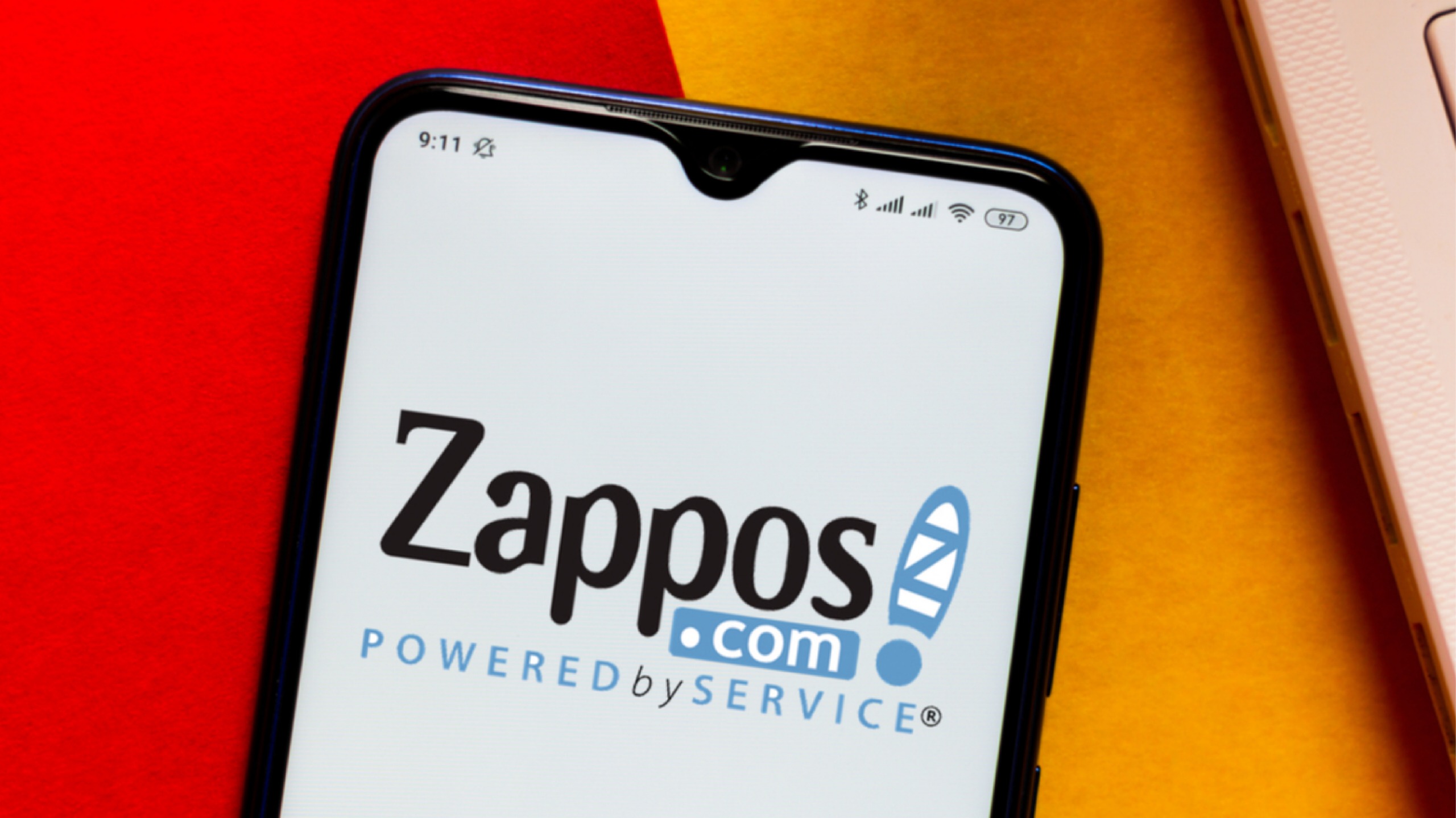
Trigger:
- Behavioral Trigger: After a customer makes a purchase, Zappos immediately triggers follow-up emails to confirm the order, provide shipping details, and offer assistance.
- Time-Based Trigger: A few days after delivery, Zappos sends a reminder email asking for feedback or a review, along with an invitation to join their loyalty program.
Results:
- Customer Satisfaction: The personalized touch and timely follow-ups contribute to an overall outstanding customer service experience.
- Repeat Business: Zappos has a remarkably high repeat customer rate due to its personalized follow-ups and seamless engagement.
Conclusion
In a world flooded with generic content, standing out requires precision. And that’s where target-based marketing truly shines, making sure that your messages are timely, tailored, and impactful.
As you implement this approach, remember: it’s all about the data. With the right insights, you can continuously refine your campaigns and keep your audience engaged. So, what’s your next step in delivering highly-targeted, impactful marketing?
Let’s turn insights into action and make your brand the one your customers can’t ignore!
